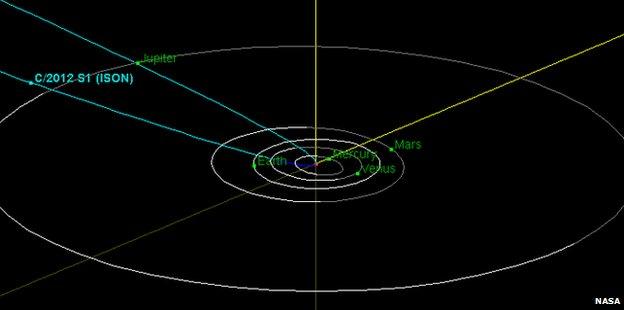Comet Ison caught on film by Deep Impact craft
- Published
Time-lapse video of Comet Ison as seen from Deep Impact craft
A comet likely to light up the skies later this year has been filmed from afar by the Deep Impact spacecraft.
Comet Ison was only discovered in September 2012 by Russian astronomers.
Its path will put it spectacularly close to the Sun in November and if it does not burn up entirely, could be the "comet of the century".
It already has a 64,000km-long tail of dust and gas that will become visible to the naked eye later in the year - a trail scientists will study closely.
"This appears to be this comet's first-ever journey into the inner Solar System and it is expected to pass much closer to the Sun than most comets," said Tony Farnham of the University of Maryland.
"Thus it offers us a novel opportunity to see how the dust and gas frozen in this comet since the dawn of our Solar System will change and evolve as it is strongly heated during its first passage close to the Sun."
Comets can act as "time capsules" delivered not only from great distances but also from times long past, as top astronomers revealed in a recent broadcast of BBC Radio 4's In Our Time.
Sungrazer
Deep Impact has already been a resounding success in the study of comets; launched in 2005, its first mission was to fire an "impactor" into comet Tempel-1 and study the debris from the impact.
That accomplished, it was redirected to take a look at "space peanut" comet Hartley-2 in late 2010.
Deep Impact has now set its sights on comet Ison during a 36-hour period in mid-January.
The comet, discovered by Vitali Nevski and Artyom Novichonok and named for their institution, the International Scientific Optical Network, is still distant: 793 million kilometres away.
It will make its closest approach to the Sun - at a distance of not much more than a million km from the Sun's surface - on 28 November.
If this "sungrazing" comet survives intact, it should emerge from the near-miss even brighter than before, and could be lighting up our skies through January 2014 - perhaps even in broad daylight.
However, comets are unpredictable and can break up or fizzle out altogether even on their approach to the Sun - so sky watchers will surely keep their eyes on Ison.

Ison lies at a distance of more than 760 million km from the Sun - but in November will pass within 1 million km
- Published30 December 2012